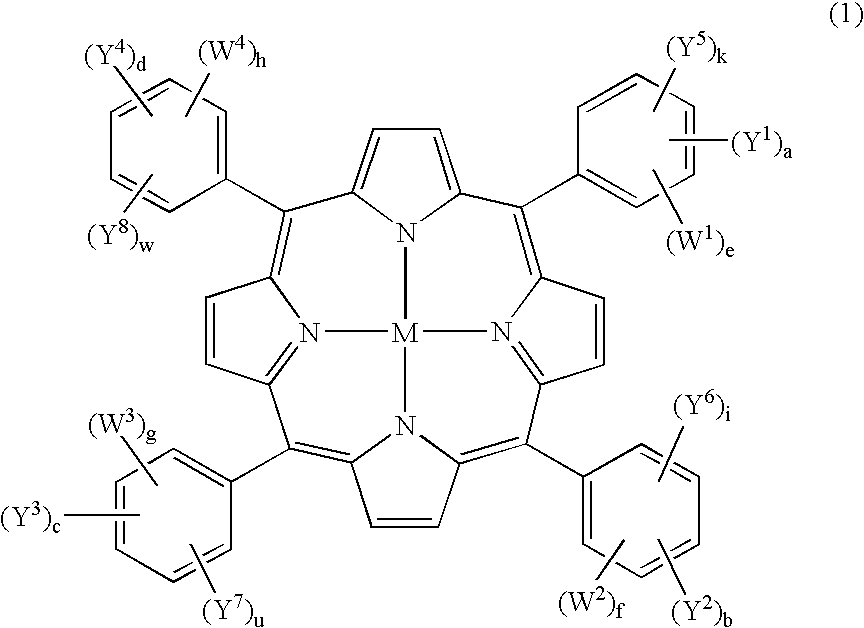Carboranylporphyrins and uses thereof
a carboranyl and porphyrin technology, applied in the field of carboranylporphyrins, can solve the problems of limited radiation and chemical treatment effect of cancer treatment methods, increased toxicity of tumor cells, and increased sensitivity of tumor cells to radiation and/or chemical treatment doses, so as to improve the sensitivity, reduce the toxicity, and the effect of increasing the polarity
- Summary
- Abstract
- Description
- Claims
- Application Information
AI Technical Summary
Benefits of technology
Problems solved by technology
Method used
Image
Examples
example 1
Synthesis of 3,5-dipropargyloxybenzylalcohol (I)
[0107]Finely powdered K2CO3, 14 grams (0.10 moles), and Kl, 17 grams (0.10 moles) were placed in a 500 mL round flask, and 200 mL acetone was added. Under a nitrogen atmosphere, 3,5-dihydroxybenzylalcohol, 4.2 grams (0.03 moles), and propargyl chloride, 5.3 grams (0.07 moles) were then added. The resulting mixture was refluxed overnight. The results from thin layer chromatography showed no starting material (3,5-dihydroxybenzylalcohol) as well as the presence of a new compound. The solution was filtered, and the filtered solid washed with acetone. The acetone of the resulting filtrate was removed by rotary evaporation, leaving an organic residue. Dichloromethane (50 mL) was added to dissolve the organic residue, and this was washed with water (30 mL×2), and then dried over anhydrous sodium sulfate. After filtering the organic phase, the solvents were removed by rotary evaporation leaving a yellow oil, which solidified upon standing. 6....
example 2
Synthesis of 3,5-dipropargyloxybenzylacetate (II)
[0109]3,5-dipropargyloxbenzylalcohol (I), 6.3 grams (0.029 moles), was stirred in 7 mL (0.07 moles) acetic anhydride. Two drops of concentrated sulfuric acid was then added to the solution. The solution was stirred in a temperature range of 90–100° C. for three hours. The results from thin layer chromatography showed no starting material (I) as well as the presence of a new compound. The solution was then poured into 50 mL of ice water. Aqueous saturated sodium carbonate solution was added slowly until the pH of the solution was at least 8, at which point there was no further release of carbon dioxide. The aqueous solution was extracted with 50 mL×2 of dichloromethane, and the organic phase was washed with water (50 mL×2) and then dried with anhydrous sodium sulfate. The desired product was purified using a pad of silica in a sintered glass funnel, the pad of silica then washed with 200 mL dichloromethane. The dichloromethane of the f...
example 3
Synthesis of 3,5-o-dicarboranylmethoxylbenzylacetate (III)
[0111]Decaborane, 2.70 grams, (0.022 moles) was dissolved in 80 mL dry toluene in a 200 mL round-bottomed flask and stirred at room temperature under a nitrogen atmosphere. Acetonitrile, 12 mL (0.22 moles), was added to the solution by syringe. The solution was then stirred for three hours. A solution composed of 2.84 grams (0.011 moles) 3,5-dipropargyloxybenzylacetate (II) in 80 mL of toluene was then added to the solution by syringe. The resulting mixture was slowly heated to 80–90° C. and stirred in that temperature range for two days. The results from thin layer chromatography showed no starting material (II) as well as the presence of a new compound. The solvents were then removed by rotary evaporation, leaving an organic residue. The organic residue was dissolved in approximately 50 mL of methanol and allowed to stir at reflux for 1 hour to decompose excess decaborane. The methanol was then removed by rotary evaporation...
PUM
| Property | Measurement | Unit |
|---|---|---|
| average energy | aaaaa | aaaaa |
| body weight | aaaaa | aaaaa |
| melting point | aaaaa | aaaaa |
Abstract
Description
Claims
Application Information
 Login to View More
Login to View More - R&D
- Intellectual Property
- Life Sciences
- Materials
- Tech Scout
- Unparalleled Data Quality
- Higher Quality Content
- 60% Fewer Hallucinations
Browse by: Latest US Patents, China's latest patents, Technical Efficacy Thesaurus, Application Domain, Technology Topic, Popular Technical Reports.
© 2025 PatSnap. All rights reserved.Legal|Privacy policy|Modern Slavery Act Transparency Statement|Sitemap|About US| Contact US: help@patsnap.com



